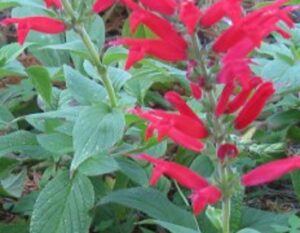Red Salvia Pineapple Sage
( salvia elegans )
 Perennial Pineapple Sage Origins:
Perennial Pineapple Sage Origins:
– Salvia Elegans is native to Guatemala and the southern areas of Mexico.
– Most often planted as an annual in cooler regions of the USA, here in North Florida / Jacksonville / St. Augustine area it will overwinter and regrow the next season if left in the ground.
– Depending on where you are in the Jacksonville | St. Augustine area and where you have it planted your Salvia Elegans Pineapple Sage may remain evergreen in the winter season or go dormant and regrow the following
spring.
– This relatively low maintenance plant is perfect for Florida’s hot summers and keeps on blooming when other flowering plants have begun to decline. Simply snap back spent flowers and foliage during the heat of the summer
and watch it regrow and rebloom all over again in a matter of weeks!
Salvia Pineapple Sage Preferred Exposure:
– Pineapple Sage will need a full sun or partial sun exposures in the North Florida | Jacksonville | St. Augustine area gardens landscape.
– To bloom its best afternoon sun is preferable to morning sun when planting in a partial sun partial shade site.
Red Pineapple Salvia Foliage:
– Medium green foliage is heart shaped and hairy or velvety textured.
– Don’t toss the roots to these plants as they are likely to regrow quickly in the following spring season.
Pineapple Sage Soil Preference / Salt tolerance:
-Salvia Elegans is not particular about the components of the soil it is planted in providing they are planted in a well draining location.
– Unknown Salt tolerance. Have it at the beach? Let us know how it did!
Pineapple Sage Size Variance:
– Pineapple Salvia can grow to heights of 3+ feet and 3 feet wide.
– Ideal for middle of the border plantings or even mixed flowering containers.
Pineapple Sage Growth Habit:
– Evergreen to herbaceous perennial plant forms an attractive mound of foliage, slightly taller than it is wide.
– Plant may tend to reseed itself into the garden!
Pineapple Sage Growth Rate:
– Fast growing Red Salvia Pineapple Sage can be expected to reach its full height in its first season after being planted in the North Florida | Jacksonville | St. Augustine area landscape.
Pineapple Sage Salvia Bloom:
– Bright red delicate flowers clustered on slightly arching stalks held just above the foliage level.
– Remove spent blooms and cut foliage back after flowering begins to decline and the plant will regrow and rebloom within weeks!
Pineapple Sage Water Requirements:
– Plants will perform best when supplimental irrigation is supplied.
– Regular water is necessary to get the plant rooted and growing on its own after being planted in the ground from a nursery container.
Butterfly or Bird Attracting:
– S & J Nursery’s Pineapple Sage will attract butterflies, bees and hummingbirds to your North Florida gardens landscape.
– These plants will be blooming at their best when other flowering plants
begin to fade extending the flowering season in late summer right through winter and into the next spring!
Best Uses For Pineapple Sage in the North Florida | Jacksonville | St. Augustine
area garden:
– Easy maintenance blooming plant for perennial beds and flower borders.
– Edible landscape plant, the foliage of the Pineapple Sage really does have
an excellent pineapple scent!, Like all members of the mint family the Pineapple Sage is a culinary treasure, add it to salads or drinks for a tropical twist! Try a few chopped leaves in one of my personal
favorites…Mango salsa!
– Great selection for a mixed container planting.
– Extend the flowering season with Pineapple Sage blooming from late summer through fall and into spring!
– Pineapple Sage makes a great companion plant for other perennials in the
garden.
– Deer resistant flowering selection!
Pineapple Sage in the North Florida | Jacksonville | St. Augustine area
landscape:
– Water every day during the establishment period after planting in the garden from a nursery container, once plants have established themselves into the landscape, you can begin to taper watering back to just a semi weekly application if local rainfall levels are low.
– Leave foliage and roots in place for next years growth.
– Trim back both foliage and blooms in early spring when flowers begin to decline or foliage has cold damaged ( depending on planting location) and allow plants to regrow new lush foliage each spring. (Make sure that if your Pineapple sage has foliage that over winters you trim back to 4-6 inches in the spring for best results.)
– Fertilize when trimming in spring and again in late summer.
– Fertilize each spring, and again when trimming in late summer with a handful of garden compost or a mixture of Milorganite and a slow release poly coated plant food such as Osmocote or Stay Green general purpose plant food or 10-10-10.

